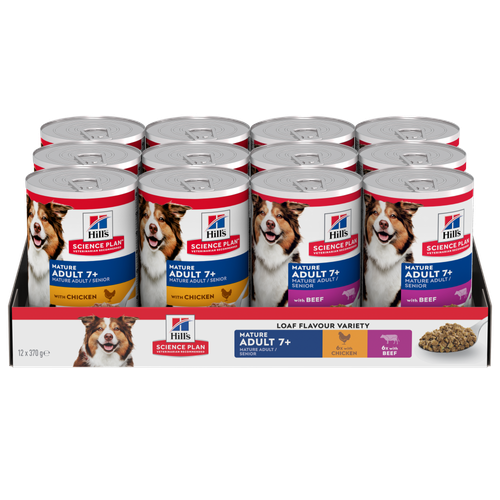
-
Find the right food for your petTake this quiz to see which food may be the best for your furry friend.Find the right food for your petTake this quiz to see which food may be the best for your furry friend.Featured products
 Adult Wet Dog Food with Beef
Adult Wet Dog Food with BeefHill's Science Plan Adult Multipack Wet Dog Food with Chicken, Beef & Turkey are complete premium pet foods for adult dogs from 1 year. Your dog will love these deliciously smooth and savoury minced loaves, formulated for balanced nutrition and overall health.
Shop Now Mature Adult Dog Food
Mature Adult Dog FoodHill's Science Plan Mature Adult Multipack Wet Dog Food with Chicken & Beef are complete premium pet foods for mature adult dogs from 7 years. Your dog will love these deliciously smooth and savoury minced loaves, formulated to deliver the appropriate amount of energy to support the needs of adult dogs.
Shop Now Puppy Food
Puppy FoodHill's Science Plan Puppy Multipack Wet Dog Food with Chicken & Beef are complete premium pet foods for growing puppies from weaning until 1 year old and for pregnant and nursing dogs. Your puppy will love these deliciously smooth and savoury minced loaves, formulated for balanced nutrition and overall health.
Shop NowFeatured products Mature Adult Wet Cat Food with Chicken
Mature Adult Wet Cat Food with Chicken
Tender chicken chunks in gravy for mature adult cats. Made with easy-to-digest ingredients, high-quality protein for lean muscle maintenance and antioxidant vitamins C+E for optimal health.
Shop Now Adult Multipack Wet Cat Food with Beef, Ocean Fish & Chicken
Adult Multipack Wet Cat Food with Beef, Ocean Fish & ChickenTender chunks in gravy for cats, with high-quality protein to maintain lean muscle. With vitamin E and omega-3s & -6s for healthy skin and balanced minerals to support healthy vital organs.
Shop Now Light Adult Multipack Wet Cat Food with Chicken & Ocean Fish
Light Adult Multipack Wet Cat Food with Chicken & Ocean FishTender chicken chunks in gravy for cats, with L-carnitine and fewer calories for ideal weight management. Packed with high-quality protein, omega-6s, and vitamin E for shiny fur and healthy skin.
Shop Now -
Dog
- Dog Tips & Articles
-
Health Category
- Weight
- Food & Environmental Sensitivities
- Urinary
- Digestive
- Joint
- Kidney
-
Life Stage
- Puppy Nutrition
- Adult Nutrition
- Senior Nutrition
Cat- Cat Tips & Articles
-
Health Category
- Weight
- Skin & Food Sensitivities
- Urinary
- Digestive
- Kidney
-
Life Stage
- Kitten Nutrition
- Adult Nutrition
Featured articles The Right Diet For Your Pet
The Right Diet For Your PetIn people, the right diet is very important. If you are eating the wrong way for your metabolism, activity level, age and lifestyle you could end up with health issues.
Read More Show some love with wet foods: a great choice for pets with health issues
Show some love with wet foods: a great choice for pets with health issuesShow some love with wet foods: a great choice for pets with health issues.
Read More The Incredible Science Behind Your Pet's Microbiome
The Incredible Science Behind Your Pet's MicrobiomeLearn what your pet's microbiome is, how it contributes to your pet's gut and overall health, and why nutrition is important in maintaining healthy microbiomes.
Read More -


One new dog at a time is challenging enough for most pet parents, and experts don't recommend adopting two puppies at once. But if you've already brought home two puppies, you can double the fun with the right training and socialisation techniques.
Are you ready to find out how to train two dogs at once? Let's learn how here.
Training Two Puppies: What Could Go Wrong?
There’s no doubt that it's more difficult to adopt two puppies at once. But by understanding and anticipating the special challenges ahead of time, owners can train and socialise both dogs to be amazing family pets.
Along with the practical considerations of adopting two puppies (How expensive will vet care be? Do I have room?) raising them has some special challenges:
Two puppies are more likely to bond to each other, rather than to their new human family.
Puppies adopted together might be anxious or timid when separated.
Dogs are individuals, so each puppy will learn and train at their own speed.


Tasty Tips
Training Strategies
If you have adopted two puppies, there are steps you can take to prevent behaviour issues and help with training multiple dogs at once. Many of these suggestions involve the puppies spending time independently:
Crate the dogs separately at night. Crate training helps with safety, damage control, house training, and travelling. Your new puppies should be crated separately and kept close enough for you to hear them at night if they need you.
Train them individually. When training two puppies, the dogs should attend training classes separately. Alternatively, if you're training at home, work with one dog while the other is with a human family member in a separate room or has a food dispensing toy to keep them occupied. You can also put each puppy on a long, comfortable lead outside to get them used to watching each other receive attention.
Socialise and play with them separately. This creates puppy independence and lets the more timid dog play without competing for your attention. You can try taking one puppy at a time with you on a short outdoor errand, or bring them over to a puppy-proofed friend's house for a meet-and-greet.
Walk them one at a time. Give each dog your undivided attention on their own daily walk. Even with separate handlers, if you always walk your puppies together, the less confident puppy will come to rely on the presence of the other dog for confidence and security. This also gives each puppy time to sniff and meet other dogs in their own way.
You're not trying to keep these two potential best friends apart from one another. Rather, you're just giving them each their own space to be who they are as they develop into well-adjusted adult dogs. As you start to understand their independent personalities and where each one shines, you can start to incorporate more group activities that allow them to train as one. Just always make sure to give each one their own share of love and attention, so that your attention doesn’t become a scarce resource that triggers squabbles or even more serious fights. Training two puppies just requires extra diligence in ensuring that each puppy is given equal attention.
A Tail of Two Dogs
You should always consider the time commitment and care costs of a new furry friend before you adopt. That’s even more important if you’re bringing home two! If you do decide to double down on dogs, you can succeed by treating them as individual personalities, by properly training them, and by spending time with them around people and other dogs. Taking these steps will help bond your dogs to you for life and put a foundation into place that helps your new puppies wiggle their way into a happy, well-adjusted life as the newest members of your family.


Kara Murphy is a freelance writer and pet parent who lives in Erie, Pa. She has a goldendoodle named Maddie.
Related products

Hill's Science Plan Hypoallergenic Adult Wet Dog Food with Salmon is a complete premium pet food for all adult dogs from 1 year. This savoury tinned loaf is specially formulated for dogs with delicate skin and stomachs. It features a single novel animal protein source and is grain-free.

Hill's Science Plan Puppy Multipack Wet Dog Food with Chicken & Beef are complete premium pet foods for growing puppies from weaning until 1 year old and for pregnant and nursing dogs. Your puppy will love these deliciously smooth and savoury minced loaves, formulated for balanced nutrition and overall health.

Hill's Science Plan Adult Multipack Wet Dog Food with Chicken, Beef & Turkey are complete premium pet foods for adult dogs from 1 year. Your dog will love these deliciously smooth and savoury minced loaves, formulated for balanced nutrition and overall health.

Hill's Science Plan Mature Adult Multipack Wet Dog Food with Chicken & Beef are complete premium pet foods for mature adult dogs from 7 years. Your dog will love these deliciously smooth and savoury minced loaves, formulated to deliver the appropriate amount of energy to support the needs of adult dogs.
Related articles

How, when and what to feed your new puppy is an important decision, learn more about the things to consider for feeding your puppy.

Many human foods are dangerous to dogs. Read about 5 of the worst toxic food offenders that can kill your dog - and how much it takes to hurt them.

Learn effective tips for feeding a dog that's a picky eater and ensure proper nutrition for a finicky eater. Discover tips for pet parents at Hill's Pet UK.

Learn about the potential health risks of a raw diet for dogs and why they aren't the best option for your pup or you.

Put your dog on a diet without them knowing
Our low calorie formula helps you control your dog's weight. It's packed with high-quality protein for building lean muscles, and made with purposeful ingredients for a flavourful, nutritious meal. Clinically proven antioxidants, Vitamin C+E, help promote a healthy immune system.
Put your dog on a diet without them knowing
Our low calorie formula helps you control your dog's weight. It's packed with high-quality protein for building lean muscles, and made with purposeful ingredients for a flavourful, nutritious meal. Clinically proven antioxidants, Vitamin C+E, help promote a healthy immune system.

